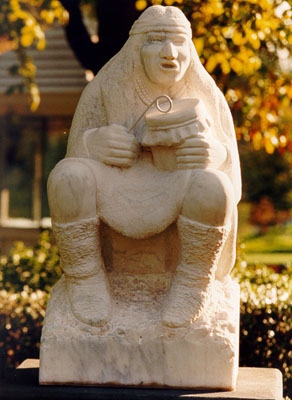
Earth Song

Allan Houser (1914 - 1994)


Allan Houser (Chiricahua Apache) 1914 - 1994
"Earth Song," 1978
Alabama marble, 48.5" x 24" x 24"
The Heard Museum, Phoenix, Arizona
Gift of The Gallery Wall, Inc. In honor of the museum's Golden Anniversary
Allan Houser has been referred to as the Grandfather of Contemporary Native American sculpture. He has without question had the most influence in establishing the cannons of Native sculpture. He was a member of the 1962 inaugural faculty at the Institute of American Indian Art (IAIA) and over the years there taught hundreds of students about sculpture. His subjects are grounded in a respect for his Apache culture and for all Indian people. Many of his themes are based on stories he heard from his father about the lifeways of the Apache people before the coming of the Europeans. Houser has blended the influences of the Mexican muralists with the sculptural designs of British artists Henry Moore to create his distinctive "Indian" sculptural style. His work has and is the marker on which all others are judged.As a young man Houser began his formal art training at the Santa Fe Indian School in a newly formed studio class. The class was taught by a young Chicago Art Institute graduate and became known as "The Studio." Houser and the students of The Studio became known for their distinct painting style of pastel colors that were outlined to create a flat and two-dimensional quality. This style of painting later became known as "Traditional Indian painting." It was at the height of his painting career that Houser began to experiment with the three-dimensional media. He first experimented with wood carvings, later working in stone and bronze. He was commissioned in 1968 to create his first monumental piece for Haskell Indian College in Lawrence, Kansas.
"Earth Song," depicts an Apache man singing a song of respect, a prayer to Mother Earth. The rhythm of his prayer is measured by the beats of his water drum as he sings to thank the earth for sustaining all living forms.